By Peter Hossli (text) and Robert Huber (photos)
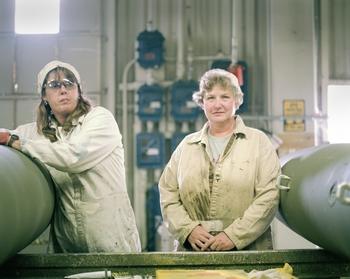
“Yes, I have a very good job”, says Carol, one of 1,000 employees at the McAlester Army Ammunition Plant (McAAP) in Oklahoma, the core of the American war machinery. Building bombs is enjoyable.
Three hours north of Dallas by car, the US Military has been manufacturing almost all their non-nuclear bombs here since September 1943. All types of explosives which can be dropped, unlike nuclear weapons. Their bombs have buried Vietnam, driven the Taliban out of Kabul and Iraq’s dictator Saddam Hussein out of Baghdad.
Carol goes home from work in the evenings feeling satisfied. After the terrorist attacks of September 11, 2001, she quit her job in a hospital and went to work for the bomb factory, “to help my country”, she says. “When I was a nurse I saved lives. Now I make bombs. That may seem like a paradox, but the bottom line is that these bombs will save more lives than kill them.” Bombs such as the phallic, 10-foot high, 2000-pound Type MK 84. “They guarantee our freedom”.
Carol is a veteran. She first stood at this workbench at the end of the 1960s when McAAP were producing weapons round the clock. In the 233-square-metre premises, 6000 bombs were produced every day and sent to Southeast Asia. Then when wars were fought coldly, it became 6000 bombs a year. By 1998 McAAP were laying off employees – the world had become too peaceful.
Now there’s a war and the staff work extra shifts on Fridays and Saturdays. The US Air Force dropped 21,000 bombs over Afghanistan and a few hundred thousand over Iraq. The depleted stock needs to be replenished. “As the only manufacturer of a very popular product, we have quite a bit to do,” says the Public Relations spokesperson Mark Hughes, an ex-marine.
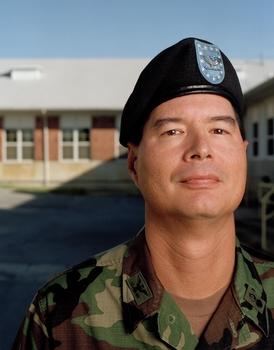
However the media is kept under constant escort and is not allowed to roam freely. Building numbers and what type of bombs are stored can neither be photographed nor reported. Only certain areas of production are open. Off limits is the “kitchen”, where explosives like TNT and PBX are concocted, melted and poured in to empty steel casings.
Hardly anyone likes to give out information. No US President or Secretary of Defence has ever visited. They have maintained their anonymity for more than sixty years with a discreet green sign next to Highway 69 stating “Army Ammunition Plant” next to Highway 69. “You journalists just tell the terrorists, Hello here we are, come and attack us”, mumbles an employee angrily. “I’m not saying anything to you.”
The American public has no idea how strategically important McAAP is for the US Armed Forces. After the surprise attack by the Japanese at Pearl Harbour in 1947, the US Congress designated an area three times the size of Manhattan, six miles south of McAlester, for the manufacturing of all conventional bombs. The location made sense. It was the only coalmining city that was centrally located and also far enough away from enemy ship cannons.
Within 18 months over 2800 buildings were constructed and today some 2200 of them serve as bunkers for storage, the main purpose of the McAAP. It is a so-called Tier-One-Storage Depot, a bomb depot of the highest importance. In an emergency they have to be able to ship 400 containers daily for a month to the troops. The extensive arsenal ranges from a 20-millimetre tank grenade to a 5000-pound penetrator bomb – the type used to destroy underground caves in Afghanistan. The public relations spokesperson cannot confirm or deny whether this arsenal includes nuclear explosives. The central location as well as the size of the warehouses makes it seem likely.
Shortly after six-thirty, it is cold and dark outside. Every second there’s an SUV or pick-up truck leaving Highway 69 where it connects Dallas with McAlester. Fifty metres before the concrete barricaded entrance, they turn in to the right. Two officials from a security firm stop and search the cars, open glove compartments and check the underside with mirrors. The security guard smiles tensely. He only lets people through with regular identity cards.
Behind the gate is the huge site, overgrown with trees and bushes,that is run by the Army and inhabited by civil servants. Architecturally, the endless rows of houses and bunkers with their railway ramps are a uniform grey. It reminds one of a Kolchos – a Soviet agricultural enterprise from the 1920s. Only eagles screeching above disturb the stillness. The production buildings, connected by 200 miles of railway tracks, seem rundown. The toilets have been waiting for a fresh coat of paint for decades.
At Post 14, a few kilometres west of the gate, past the red brick administration buildings, is another control. Smokers have to put their lighters and matches in a metal bucket – behind Post 14 are the explosives production facilities. Workers wear shoes with lead caps, to earth any electric charges, protective glasses, and on their heads, a beige protective cap to ensure no electricity charged hair can spark an explosive.
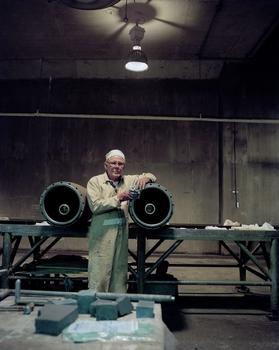
The pay is particularly good. Novices earn $11.22 per hour. Experienced workers can earn up to $25 – three times more than the average salary in McAlester. In addition, they get lots of vacation and (with extra shifts on Fridays and Saturdays) big bonuses. Health and Dental insurance cost nothing for McAAP employees.
James is determined to deliver “only the highest quality bombs”. “Only the best is good enough.”
He needs strong hands for this. Bombs Made in USA are primarily handmade. Except for the lifting, the workers here handle every production step themselves. They pour tar in to steel casings, scrape the overflow off, screw the holders tight for the fighter jets, boil and pour the liquid explosives, thread the wires for the fuse, and at the end, they seal the bombs. It’s not a complex production process.
With both hands James hangs a bomb on to an iron hook. It dangles like an oversized sausage from the grey concrete ceiling. A conveyor belt moves it around the corner, where Debbie, takes the empty projectile and weighs it. It’s twice the size of her and many times heavier. The Swiss precision scale from Mettler Toledo rates it as 1149 pounds. The next bomb weighs 1151 pounds and the next 1153 pounds. The empty weight determines the amount of TNT or PBX that is poured in to the bomb.
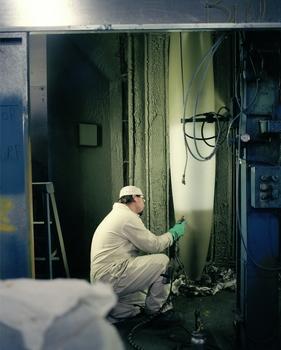
A simple memorial, idyllically placed on the edge of an artificial lake is a reminder to the dangers of working in the bomb factory. 25 people have died so far at the McAAP site. An employee was crushed by a bomb last year. In 1944 twelve people were killed in an explosion.
Steve has been exclusively building the 2000-pound Type MK 84 bomb for a few weeks now. This is the Volkswagen Beetle of the US arsenal – the all-purpose bomb. The Air Force, Navy and the Marines all use them. No other bomb is dropped more often, 12,000 of them the Gulf War in 1991. The bomb is already effective in freefall, but equipped with a navigational apparatus and wings it can be transformed into a smart weapon. Jet fighters like the F-18 or the B-52 and B-1 Bombers carry them. The steel shell weighs 1500 pounds, but the explosive only 500 pounds. There is a reason for this. The bomb’s enormous lethal capacity is caused by thousands of pieces of metal shrapnel that blow in all directions when it explodes.
Manufacturing costs for the MK 84 are $3,500. The empty steel casings cost $1000, the explosives and labour cost $2,500. The navigation system – “the laserbrain”, as they call it – increases the price by $27,000.
The strategic importance of the bomb has increased. US Armed Forces must begin and decide wars more rapidly, claimed US Defense Secretary Donald Rumsfeld in a strategy report. He accorded the bomb, especially the laser-driven one, a special status. Thanks to the bomb, armed conflicts can be fought with fewer ground troops, and thus fewer American deaths. “Bombs allow us to fight wars from a distance”, says Colonel Hewitt. He is one of the few McAAP employees in uniform. “They are ideal for destroying targets, while at the same time protecting our pilots.”
The navigation system is manufactured by Boeing. But without explosives, according to Hewitt, “even the most precise navigation system is useless”. Here they produce “every piece of the bomb that goes boom” says Hewitt. “Our bombs explode even without a navigation system”, the Commander adds”.
At 9:00 everyone stops. Coffee break. The smokers squeeze themselves in to a narrow fireproof room. Silently they play dominos. Non-smokers pour thin, brown coffee in to Styrofoam cups. They read magazines about hunting, cars and the rich and the beautiful. First hesitantly, than animatedly, a reporter’s question kindles a discussion.
“I’m for the war in Iraq, and then the world will know where McAlester is”, says one.
“Our product would bring the deciding advantage”, another says.
“In McAlester there are no warmongers, but September 11th woke us up” says James. “We should have done more after the attacks in Kenya and Tanzania or on the USS Cole.”
“Bill Clinton was too busy with other things”, jokes one, “he is also responsible for 9/11.”
He’s proud about the way the war ended in Afghanistan with its McAAP bombs. “No one likes to kill”, says James “but these bastards got what they deserve.” A shrill alarm is the abrupt signal that the break is over.
The McAlester Army Ammunition Plant belongs to the US government. “We’re not political here”, says Colonel Hewitt. “We carry out what Washington demands.” If the Pentagon orders a certain amount of a certain type of bomb, the McAAP delivers it to the requested site. “We don’t ask any questions”, say Hewitt. “Since the war in Afghanistan, we hold our heads a bit higher here”, he says. In front of his office he had a plaque installed that shows a Marine carting a McAAP bomb under a B-1 Bomber during the “Enduring Freedom” campaign in Central Asia. “We have a direct line to the pilots”, according to Hewitt.
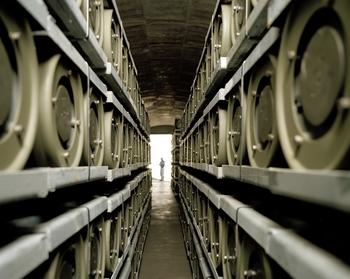
Some of the bunkers are covered with a tarpaulin so that trees can’t put down roots or damp get in. An air vent takes care of air circulation. Each warehouse is earthed and holds around 250 2000-pounders. A concrete wall in front of the steel door is designed to ensure that, in an accident, an explosion would explode vertically rather than laterally. There is 250 metres of grassland between each igloo to prevent a chain reaction.
Grazing here are deer, wild boars and lynxes watching for rabbits. The world’s largest bomb factory looks more like a nature reserve. Every once in a while a train rattles by; otherwise the premises are completely still. At the weekends it somewhat busier when 300 hunters go deer stalking with bows and arrows (guns are forbidden). “They help control the deer overpopulation”, says hunting warden Bill Starry.
Firearms jeopardise safety and this is the number one rule here, as evident in the numerous signs posted along the main road. 300 twenty-metre high steel rods surround the production buildings which are covered with corrugated metal roofs. These direct any electric current from lightening to the ground. If a tornado or a thunderstorm sweeps across the flat plains, the production line stops immediately and all employees move to the bad weather bunker.
Actually, the emergency exits are a bit of a joke. If something really does happen, there will be no time to escape. After 9/11 hunting was suspended. Instead, National Guard Reserve Members set up camp here and stayed ten months. Now the campgrounds belong to the hunters again.
The mood is relaxed on the evening before the first hunt of the season. Campfires blaze. Coffee bubbles. Seven hunters are ready to go in their green-brown camouflage suits. Each fires off four arrows into the heart of a painted deer. Tomorrow they’ll be aiming at real bucks.
A few hundred metres away from the hunters is a convoy of eight heavy trucks. None of these nondescript trailers are marked in any way. An inspector weighs and seals them with two metal wires. Private firms transport the bombs from McAlester to the “end buyer” – as the customer is referred to –other depots, air force bases or to the Gulf of Mexico.
The drivers of this explosive freight receive lucrative bonuses. There are elaborate checks in place for guaranteeing that the bombs reach their designated site, says the inspector, who at the moment is sealing “an above average number” of trucks.
Trucks loaded up with bombs, driving up and down the highways, doesn’t bother McAlester Mayor, Dale Covington. “Without McAAP our town would be nothing”, he says as he settles into his brown leather chair. Behind him is an oil painting of a cowboy riding in the barren prairie. ”If there is a war anywhere, the world will find out about us”, he says, “it would be nice if McAlester became more well-known.”
It would probably improve their image. Nowhere else have there been as many prisoners executed last year as in McAlester, not even in Texas. “I would rather the world knows us as bomb manufacturers than as an execution centre,” he says. And it’s an important economical boost: “the rest of the country might be pinched economically, but we’re doing wonderfully”, says the Mayor.
Protests over the ear-deafening detonations of discarded bombs have faded away – McAlester’s bombs have become environmentally friendly. They are 100 percent recyclable.
Clouds hang above in the clear blue sky. Below them lie 10,000 empty artillery shells from the Vietnam War era. The guns that once fired them have been scrapped and the ammunition has become obsolete. Until recently, every day at lunchtime this ammunition was blown up.
Now bombs that have been defused are heated with hot steam, and the contents melted, poured out, cooled down and used again. The empty steel casings are bought by the highest bidder. Automobile manufacturers will sometimes admit to making new Toyotas or Volvos from old bombs. Soon McAAP will be using a machine that can freeze bombs and then destroy them into a thousand tiny pieces without an explosion.
Recycling has increased their turnover profits. McAAP turnover is between $100-120 million. Sales Director, Brian Lott, estimates the value of the depot’s stock is worth about seven billion US dollars. Bombs are not just supplied to the USA but also Canada, England and the Czech Republic. Recently McAAP had a complex disinfection machine installed for the wooden pallets that bombs are exported on. It destroys parasites that are forbidden in the EU.
A diesel-powered red locomotive pulls three yellow freight cars to the front of a concrete ramp. Every vehicle is stamped with “United States Army”. A forklift takes two freshly tarred bombs from the vehicle and lays them on the counter where three workers screw the brass airplane holders on. It’s loud. A booming machine sands down the steel casings. Everyone wears earplugs. In a sealed, violet-lit room, grey rust protection is spread on.
From there the bombs end up with Ronnie. Ronnie is the painter and he gives every explosive its unmistakable olive green appearance. He has a goatee and he smiles. He lets the dangling bomb turn around on its own axle. He sprays it the standard military colour. He kneels down and paints the blunted point in yellow. Then Ronnie shoves the 2000-pounder further to his wife Pam. She dries the bomb with a blower.
Ronnie and Pam fell in love in the loud halls between the paint spray department and the ventilators. Their two children spend the day at the company daycare centre with 40 others whose parents build bombs. “In the evenings we do make it a point to talk about other things”, says Pam. She is chattier than Ronnie. Instead of the standard protective glasses she wears tinted stylish sunglasses. And in place of the official sock cap she wears a baseball cap, with her hair pulled through at the back.
She hates it when strangers point through the barriers. “Because I can’t join the military, I work here”, she says, “I want to defend my country.” She’s all for the war in Iraq, and “not just because we get more work.” On Sept. 11th “the enemies ambushed us”. Similar attacks have to be stopped at any price. Her motto: “An eye for an eye.”
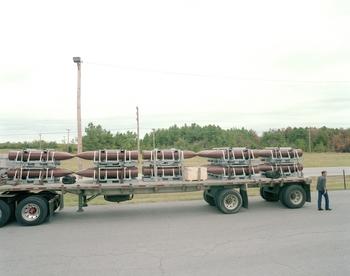
With no lid they arrive in the completion area from the kitchen. Men fill them with grey PBX-pap till just under the rim. Then they hand the bombs over to Emma and Sonja, Carol and Joe. They fill and scrape off the overflow of PBX. Lastly they press a yellow sticker on that says where and when the bomb was produced and what it contains.
The women don’t think consciously about the fact that bombs kill. “This is a job like any other, just better paid”, says one. “If someone thought too much about the consequences, they would go insane.”
